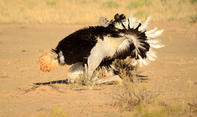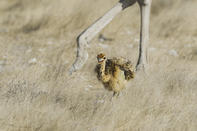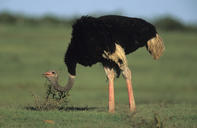Communal Breeders

Courtship in ostriches is a spectacular affair. The males acquire scarlet colouring on their beaks, foreheads, necks and shins. They chase each other around frantically in competition and dance alluringly for the females to achieve dominance.
Males will approach females with an exaggerated prancing gait, feathers raised, and then will drop to their knees as if in proposal while waving the wings to reveal their white tips and twisting their necks corkscrew-like.
Ostriches have a fairly unique breeding system amongst birds and are referred to as communal breeders. The male is polygamous, he has more than one mate, but within his group of females there is only one major hen, the rest being minor hens.
Of the females, only the major hen incubates the eggs and this she does in a shallow scrape in the ground two metres across. She lays her eight or ten eggs first and the minor hens add theirs to her collection, potentially upping the total to 40.
Usually, the minor hen’s eggs are moved to the sides, but the parent birds can effectively cover at least 20 eggs when they are sitting on the nest, and so there is a good chance that some of the minor hens’ eggs will be incubated full term.
Excess eggs that may roll out of the nest or be poached, by the likes of hyena, are likely to be the minor hens’, and this is probably a useful insurance policy for the major hen, and the reason she allows the others to lay on her turf at all.
Strange and Unusual
Strangely for ground-nesting birds, ostriches have white eggs. Many ground nesters produce cryptically coloured eggs. The ostrich parents provide the concealment. The paler brown female incubates the eggs by day, lowering her neck and flattening herself out if threatened to resemble a rock from far.
This is where the myth comes from that ostriches bury their heads. The black-feathered male takes the night shift blending in with the cover of darkness. The eggs, when unattended, are also protected from overheating by being white and glossy as they are usually laid in stony, exposed areas and only incubated once the whole clutch has been laid.
Ostriches have the largest eggs of all birds but they only constitute 1.5% of the female’s weight and are therefore not that large for the bird producing them. By comparison, the New Zealand Kiwi lays an egg weighing 25% of the female’s weight, and this is proportionally the largest egg laid by a bird.
It takes two days for the hard-shelled eggs to form in the female, it usually takes 24 hours in other birds, and when they are laid they can weigh in anywhere between 800 g and 1500 g. The shell is 2 mm thick and the egg has the capacity of 24 chicken eggs.
Struggling is Good

The eggs may be white but the chicks, when they hatch, are earthen-coloured and cryptic to escape the attentions of jackal, caracal and raptors like martial eagles, which only a third of them manage to do.
Life for an ostrich chick starts out tough, as it must struggle its way through the very hard shell of its egg. This initiation has a purpose, as the struggling draws a yolk sac into its body in the process, and the chick then subsists on this yolk for the first 24 hours of its life. Like a butterfly, helping the youngster out of its incarceration could prove a death sentence, as the sack may then not be absorbed.
Once they do start feeding, ostrich chicks will eat whatever they can swallow. This is because the gizzard (muscular stomach), where mechanical digestion takes place, requires hard objects such as stones to facilitate the mastication of the real food material ingested.
Adult birds also deliberately swallow stones, to equip their gizzards with grinding tools. Real food for ostriches includes succulent plants, grass, berries, seeds, insects and small reptiles. Ostriches are gregarious and live together in flocks.
Different flocks may even merge their groups of chicks into crèches. This provides safety in numbers and improved vigilance.

